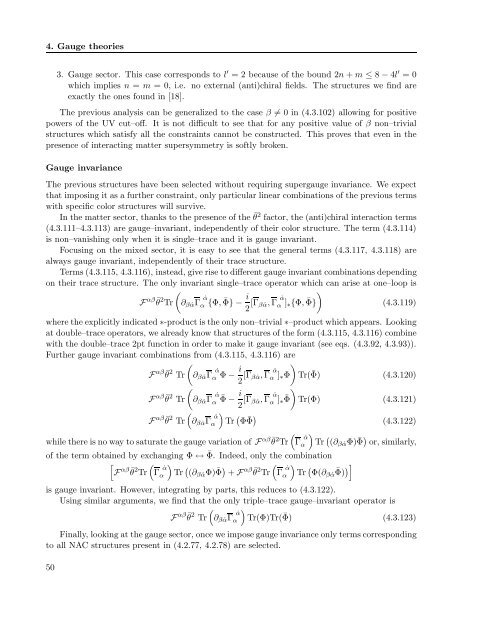Perturbative and non-perturbative infrared behavior of ...
Perturbative and non-perturbative infrared behavior of ...
Perturbative and non-perturbative infrared behavior of ...
Create successful ePaper yourself
Turn your PDF publications into a flip-book with our unique Google optimized e-Paper software.
4. Gauge theories<br />
3. Gauge sector. This case corresponds to l ′ = 2 because <strong>of</strong> the bound 2n + m ≤ 8 − 4l ′ = 0<br />
which implies n = m = 0, i.e. no external (anti)chiral fields. The structures we find are<br />
exactly the ones found in [18].<br />
The previous analysis can be generalized to the case β = 0 in (4.3.102) allowing for positive<br />
powers <strong>of</strong> the UV cut–<strong>of</strong>f. It is not difficult to see that for any positive value <strong>of</strong> β <strong>non</strong>–trivial<br />
structures which satisfy all the constraints cannot be constructed. This proves that even in the<br />
presence <strong>of</strong> interacting matter supersymmetry is s<strong>of</strong>tly broken.<br />
Gauge invariance<br />
The previous structures have been selected without requiring supergauge invariance. We expect<br />
that imposing it as a further constraint, only particular linear combinations <strong>of</strong> the previous terms<br />
with specific color structures will survive.<br />
In the matter sector, thanks to the presence <strong>of</strong> the ¯ θ2 factor, the (anti)chiral interaction terms<br />
(4.3.111–4.3.113) are gauge–invariant, independently <strong>of</strong> their color structure. The term (4.3.114)<br />
is <strong>non</strong>–vanishing only when it is single–trace <strong>and</strong> it is gauge invariant.<br />
Focusing on the mixed sector, it is easy to see that the general terms (4.3.117, 4.3.118) are<br />
always gauge invariant, independently <strong>of</strong> their trace structure.<br />
Terms (4.3.115, 4.3.116), instead, give rise to different gauge invariant combinations depending<br />
on their trace structure. The only invariant single–trace operator which can arise at one–loop is<br />
F αβ ¯ θ 2 Tr<br />
<br />
∂β ˙αΓ ˙α<br />
α {Φ, ¯ Φ} − i<br />
2 [Γβ ˙α,Γ ˙α<br />
α ]∗{Φ, ¯ Φ}<br />
<br />
(4.3.119)<br />
where the explicitly indicated ∗-product is the only <strong>non</strong>–trivial ∗–product which appears. Looking<br />
at double–trace operators, we already know that structures <strong>of</strong> the form (4.3.115, 4.3.116) combine<br />
with the double–trace 2pt function in order to make it gauge invariant (see eqs. (4.3.92, 4.3.93)).<br />
Further gauge invariant combinations from (4.3.115, 4.3.116) are<br />
F αβ ¯ θ 2 Tr<br />
F αβ ¯ θ 2 Tr<br />
F αβ ¯ θ 2 Tr<br />
<br />
<br />
∂β ˙αΓ ˙α<br />
α Φ − i<br />
∂β ˙αΓ ˙α<br />
α ¯ Φ − i<br />
<br />
∂β ˙αΓ ˙α<br />
α<br />
while there is no way to saturate the gauge variation <strong>of</strong> F αβ ¯ θ 2 Tr<br />
Γ ˙α<br />
α<br />
2 [Γβ ˙α,Γ ˙α<br />
<br />
α ]∗Φ Tr( ¯ Φ) (4.3.120)<br />
2 [Γβ ˙α,Γ ˙α<br />
α ]∗ ¯ <br />
Φ<br />
<br />
Tr<br />
Tr(Φ) (4.3.121)<br />
Φ¯ Φ <br />
(4.3.122)<br />
<br />
Tr (∂β ˙αΦ) ¯ Φ or, similarly,<br />
<strong>of</strong> the term obtained by exchanging Φ ↔ ¯ Φ. Indeed, only the combination<br />
<br />
F αβ <br />
θ¯ 2<br />
Tr Tr (∂β ˙αΦ) ¯ Φ + F αβ <br />
θ¯ 2<br />
Tr Tr Φ(∂β ˙α ¯ Φ) <br />
is gauge invariant. However, integrating by parts, this reduces to (4.3.122).<br />
Using similar arguments, we find that the only triple–trace gauge–invariant operator is<br />
F αβ <br />
θ¯ 2<br />
Tr Tr(Φ)Tr( ¯ Φ) (4.3.123)<br />
<br />
∂β ˙αΓ ˙α<br />
α<br />
Finally, looking at the gauge sector, once we impose gauge invariance only terms corresponding<br />
to all NAC structures present in (4.2.77, 4.2.78) are selected.<br />
50<br />
Γ ˙α<br />
α<br />
Γ ˙α<br />
α
















